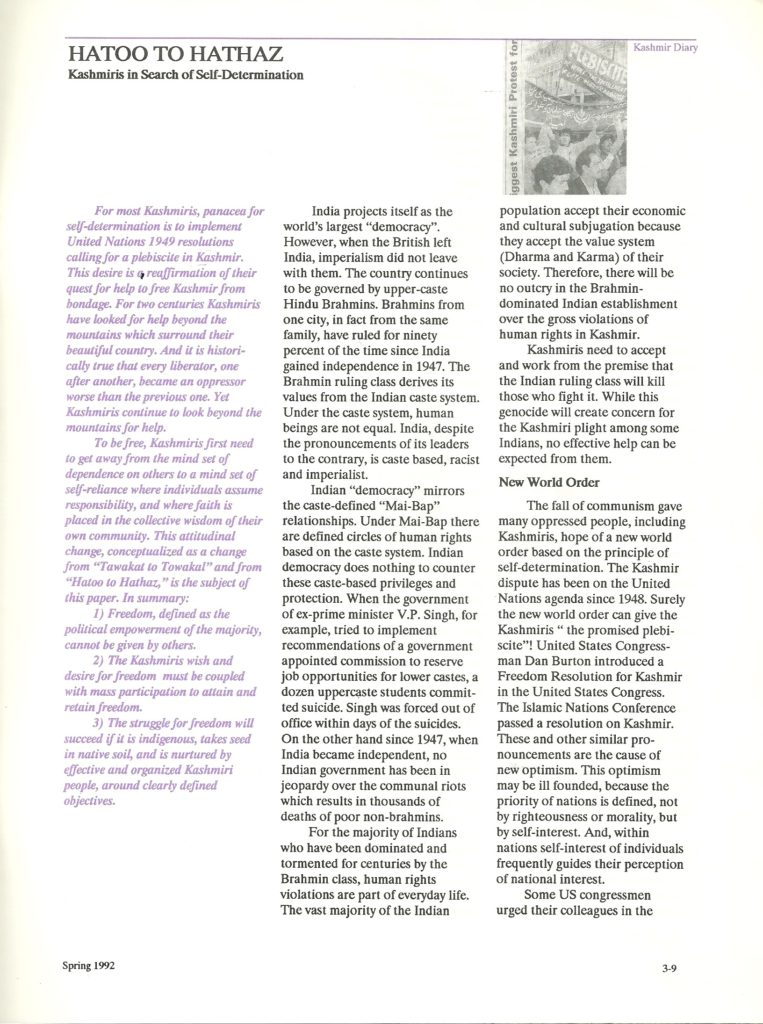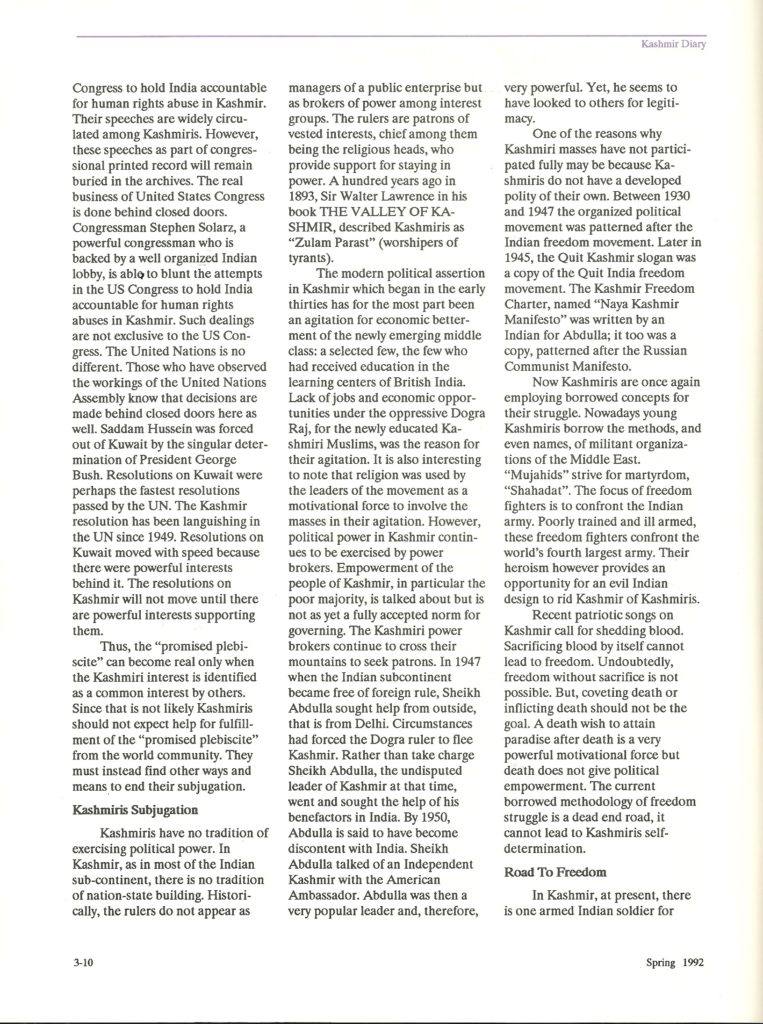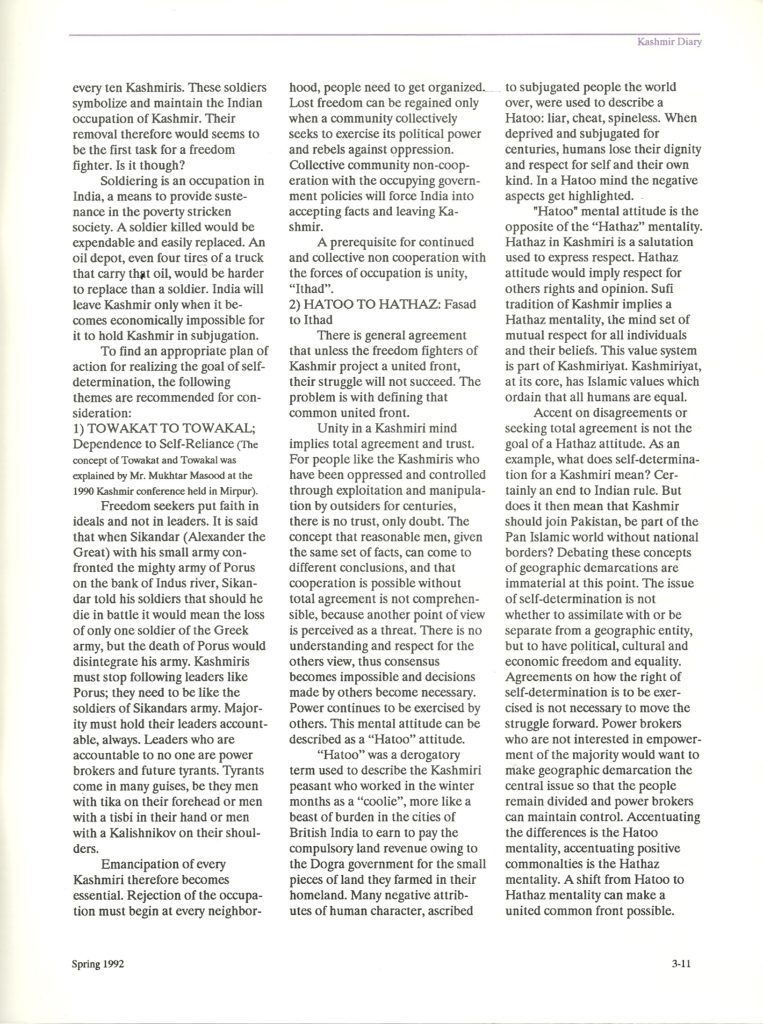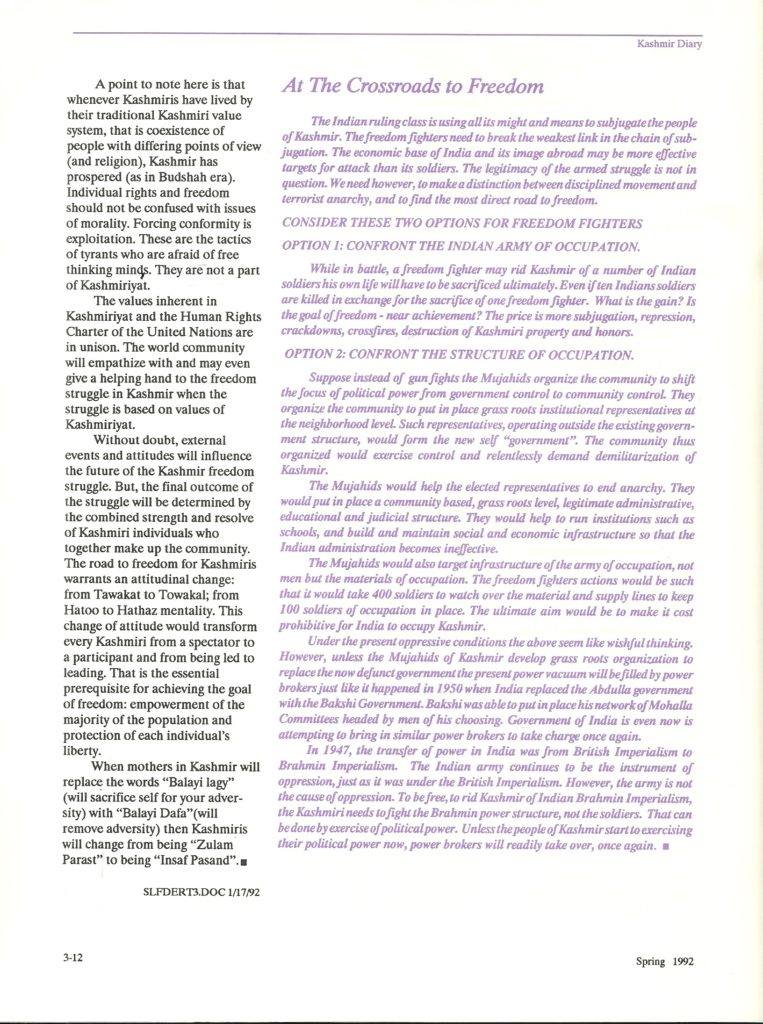This is an article from Kashmir Diary, published in Volume 1 Number 3 (Spring 1992). We have both reprinted the original article in images and replicated the text, below.




HATOO TO HATHAZ
Kashmiris in Search of Self-Determination
For most Kashmiris, panacea for self-determination is to implement United Nations 1949 resolutions calling for a plebiscite in Kashmir. This desire is a reaffirmation of their quest for help to free Kashmir from bondage. For two centuries Kashmiris have looked for help beyond the mountains which surround their beautiful country. And it is historically true that every liberator, one after another, became an oppressor worse than the previous one. Yet Kashmiris continue to look beyond the mountains for help.
To be free, Kashmiris first need to get away from the mind set of dependence on others to a mind set of self-reliance where individuals assume responsibility, and where faith is placed in the collective wisdom of their own community. This attitudinal change, conceptualized as a change from “Tawakat to Towakal” and from “Hatoo to Hathaz,” is the subject of this paper. In summary:
1) Freedom, defined as the political empowerment of the majority, cannot be given by others.
2) The Kashmiris wish and desire for freedom must be coupled with mass participation to attain and retain freedom.
3) The struggle for freedom will succeed if it is indigenous, takes seed in native soil, and is nurtured by effective and organized Kashmiri people, around clearly defined objectives.
India projects itself as the world’s largest “democracy”. However, when the British left India, imperialism did not leave with them. The country continues to be governed by upper-caste Hindu Brahmins. Brahmins from one city, in fact from the same family, have ruled for ninety percent of the time since India gained independence in 1947. The Brahmin ruling class derives its values from the Indian caste system. Under the caste system, human beings are not equal. India, despite the pronouncements of its leaders to the contrary, is caste based, racist and imperialist.
Indian “democracy” mirrors the caste-defined “Mai-Bap” relationships. Under Mai-Bap there are defined circles of human rights based on the caste system. Indian democracy does nothing to counter these caste-based privileges and protection. When the government of ex-prime minister V.P. Singh, for example, tried to implement recommendations of a government appointed commission to reserve job opportunities for lower castes, a dozen uppercaste students committed suicide. Singh was forced out of office within days of the suicides. On the other hand since 1947, when India became independent, no Indian government has been in jeopardy over the communal riots which results in thousands of deaths of poor non-brahmins.
For the majority of Indians who have been dominated and tormented for centuries by the Brahmin class, human rights violations are part of everyday life. The vast majority of the Indian population accept their economic and cultural subjugation because they accept the value system (Dharma and Karma) of their society. Therefore, there will be no outcry in the Brahmin-dominated Indian establishment over the gross violations of human rights in Kashmir.
Kashmiris need to accept and work from the premise that the Indian ruling class will kill those who fight it. While this genocide will create concern for the Kashmiri plight among some Indians, no effective help can be expected from them.
New World Order
The fall of communism gave many oppressed people, including Kashmiris, hope of a new world order based on the principle of self-determination. The Kashmir dispute has been on the United Nations agenda since 1948. Surely the new world order can give the Kashmiris ” the promised plebiscite”! United States Congress-man Dan Burton introduced a Freedom Resolution for Kashmir in the United States Congress. The Islamic Nations Conference passed a resolution on Kashmir. These and other similar pronouncements are the cause of new optimism. This optimism may be ill founded, because the priority of nations is defined, not by righteousness or morality, but by self-interest. And, within nations self-interest of individuals frequently guides their perception of national interest.
Some US congressmen urged their colleagues in the Congress to hold India accountable for human rights abuse in Kashmir. Their speeches are widely circulated among Kashmiris. However, these speeches as part of congressional printed record will remain buried in the archives. The real business of United States Congress is done behind closed doors. Congressman Stephen Solarz, a powerful congressman who is backed by a well organized Indian lobby, is able to blunt the attempts in the US Congress to hold India accountable for human rights abuses in Kashmir. Such dealings are not exclusive to the US Congress. The United Nations is no different. Those who have observed the workings of the United Nations Assembly know that decisions are made behind closed doors here as well. Saddam Hussein was forced out of Kuwait by the singular determination of President George Bush. Resolutions on Kuwait were perhaps the fastest resolutions passed by the UN. The Kashmir resolution has been languishing in the UN since 1949. Resolutions on Kuwait moved with speed because there were powerful interests behind it. The resolutions on Kashmir will not move until there are powerful interests supporting them.
Thus, the “promised plebiscite” can become real only when the Kashmiri interest is identified as a common interest by others. Since that is not likely Kashmiris should not expect help for fulfillment of the “promised plebiscite” from the world community. They must instead find other ways and means to end their subjugation.
Kashmiris Subjugation
Kashmiris have no tradition of exercising political power. In Kashmir, as in most of the Indian sub-continent, there is no tradition of nation-state building. Historically, the rulers do not appear as managers of a public enterprise but as brokers of power among interest groups. The rulers are patrons of vested interests, chief among them being the religious heads, who provide support for staying in power. A hundred years ago in 1893, Sir Walter Lawrence in his book THE VALLEY OF KASHMIR, described Kashmiris as “Zulam Parast” (worshipers of tyrants).
The modern political assertion in Kashmir which began in the early thirties has for the most part been an agitation for economic betterment of the newly emerging middle class: a selected few, the few who had received education in the learning centers of British India. Lack of jobs and economic opportunities under the oppressive Dogra Raj, for the newly educated Kashmiri Muslims, was the reason for their agitation. It is also interesting to note that religion was used by the leaders of the movement as a motivational force to involve the masses in their agitation. However, political power in Kashmir continues to be exercised by power brokers. Empowerment of the people of Kashmir, in particular the poor majority, is talked about but is not as yet a fully accepted norm for governing. The Kashmiri power brokers continue to cross their mountains to seek patrons. In 1947 when the Indian subcontinent became free of foreign rule, Sheikh Abdulla sought help from outside, that is from Delhi. Circumstances had forced the Dogra ruler to flee Kashmir. Rather than take charge Sheikh Abdulla, the undisputed leader of Kashmir at that time, went and sought the help of his benefactors in India. By 1950, Abdulla is said to have become discontent with India. Sheikh Abdulla talked of an Independent Kashmir with the American Ambassador. Abdulla was then a very popular leader and, therefore, very powerful. Yet, he seems to have looked to others for legitimacy.
One of the reasons why Kashmiri masses have not participated fully may be because Kashmiris do not have a developed polity of their own. Between 1930 and 1947 the organized political movement was patterned after the Indian freedom movement. Later in 1945, the Quit Kashmir slogan was a copy of the Quit India freedom movement. The Kashmir Freedom Charter, named “Naya Kashmir Manifesto” was written by an Indian for Abdulla; it too was a copy, patterned after the Russian Communist Manifesto.
Now Kashmiris are once again employing borrowed concepts for their struggle. Nowadays young Kashmiris borrow the methods, and even names, of militant organizations of the Middle East. “Mujahids” strive for martyrdom, “Shahadat”. The focus of freedom fighters is to confront the Indian army. Poorly trained and ill armed, these freedom fighters confront the world’s fourth largest army. Their heroism however provides an opportunity for an evil Indian design to rid Kashmir of Kashmiris.
Recent patriotic songs on Kashmir call for shedding blood. Sacrificing blood by itself cannot lead to freedom. Undoubtedly, freedom without sacrifice is not possible. But, coveting death or inflicting death should not be the goal. A death wish to attain paradise after death is a very powerful motivational force but death does not give political empowerment. The current borrowed methodology of freedom struggle is a dead-end road, it cannot lead to Kashmiris self-determination.
Road To Freedom
In Kashmir, at present, there is one armed Indian soldier for every ten Kashmiris. These soldiers symbolize and maintain the Indian occupation of Kashmir. Their removal therefore would seems to be the first task for a freedom fighter. Is it though?
Soldiering is an occupation in India, a means to provide sustenance in the poverty stricken society. A soldier killed would be expendable and easily replaced. An oil depot, even four tires of a truck that carry that oil, would be harder to replace than a soldier. India will leave Kashmir only when it be-comes economically impossible for it to hold Kashmir in subjugation.
To find an appropriate plan of action for realizing the goal of self-determination, the following themes are recommended for consideration:
- TOWAKAT TO TOWAKAL; Dependence to Self-Reliance (The concept of Towakat and Towakal was explained by Mr. Mukhtar Masood at the 1990 Kashmir conference held in Mirpur).
Freedom seekers put faith in ideals and not in leaders. It is said that when Sikandar (Alexander the Great) with his small army con-fronted the mighty army of Porus on the bank of Indus river, Sikan-dar told his soldiers that should he die in battle it would mean the loss of only one soldier of the Greek army, but the death of Porus would disintegrate his army. Kashmiris must stop following leaders like Porus; they need to be like the soldiers of Sikandars army. Majority must hold their leaders accountable, always. Leaders who are accountable to no one are power brokers and future tyrants. Tyrants come in many guises, be they men with tika on their forehead or men with a tisbi in their hand or men with a Kalishnikov on their shoulders.
Emancipation of every Kashmiri therefore becomes essential. Rejection of the occupation must begin at every neighborhood, people need to get organized, Lost freedom can be regained only when a community collectively seeks to exercise its political power and rebels against oppression. Collective community non-cooperation with the occupying government policies will force India into accepting facts and leaving Kashmir.
A prerequisite for continued and collective non-cooperation with the forces of occupation is unity, “Ithad”.
- HATOO TO HATHAZ: Fasad to Ithad
There is general agreement that unless the freedom fighters of Kashmir project a united front, their struggle will not succeed. The problem is with defining that common united front.
Unity in a Kashmiri mind implies total agreement and trust. For people like the Kashmiris who have been oppressed and controlled through exploitation and manipulation by outsiders for centuries, there is no trust, only doubt. The concept that reasonable men, given the same set of facts, can come to different conclusions, and that cooperation is possible without total agreement is not comprehensible, because another point of view is perceived as a threat. There is no understanding and respect for the others view, thus consensus becomes impossible and decisions made by others become necessary. Power continues to be exercised by others. This mental attitude can be described as a “Hatoo” attitude.
“Hatoo” was a derogatory term used to describe the Kashmiri peasant who worked in the winter months as a “coolie”, more like a beast of burden in the cities of British India to earn to pay the compulsory land revenue owing to the Dogra government for the small pieces of land they farmed in their homeland. Many negative attributes of human character, ascribed to subjugated people the world over, were used to describe a Hatoo: liar, cheat, spineless. When deprived and subjugated for centuries, humans lose their dignity and respect for self and their own kind. In a Hatoo mind the negative aspects get highlighted.
“Hatoo” mental attitude is the opposite of the “Hathaz” mentality. Hathaz in Kashmiri is a salutation used to express respect. Hathaz attitude would imply respect for others rights and opinion. Sufi tradition of Kashmir implies a Hathaz mentality, the mind set of mutual respect for all individuals and their beliefs. This value system is part of Kashmiriyat. Kashmiriyat, at its core, has Islamic values which ordain that all humans are equal.
Accent on disagreements or seeking total agreement is not the goal of a Hathaz attitude. As an example, what does self-determination for a Kashmiri mean? Certainly an end to Indian rule. But does it then mean that Kashmir should join Pakistan, be part of the Pan Islamic world without national borders? Debating these concepts of geographic demarcations are immaterial at this point. The issue of self-determination is not whether to assimilate with or be separate from a geographic entity, but to have political, cultural and economic freedom and equality. Agreements on how the right of self-determination is to be exercised is not necessary to move the struggle forward. Power brokers who are not interested in empowerment of the majority would want to make geographic demarcation the central issue so that the people remain divided and power brokers can maintain control. Accentuating the differences is the Hatoo mentality, accentuating positive commonalties is the Hathaz mentality. A shift from Hatoo to Hathaz mentality can make a united common front possible.
A point to note here is that whenever Kashmiris have lived by their traditional Kashmiri value system, that is coexistence of people with differing points of view (and religion), Kashmir has prospered (as in Budshah-era). Individual rights and freedom should not be confused with issues of morality. Forcing conformity is exploitation. These are the tactics of tyrants who are afraid of free thinking minds. They are not a part of Kashmiriyat.
The values inherent in Kashmiriyat and the Human Rights Charter of the United Nations are in unison. The world community will empathize with and may even give a helping hand to the freedom struggle in Kashmir when the struggle is based on values of Kashmiriyat.
Without doubt, external events and attitudes will influence the future of the Kashmir freedom struggle. But, the final outcome of the struggle will be determined by the combined strength and resolve of Kashmiri individuals who together make up the community. The road to freedom for Kashmiris warrants an attitudinal change: from Tawakat to Towakal; from Hatoo to Hathaz mentality. This change of attitude would transform every Kashmiri from a spectator to a participant and from being led to leading. That is the essential prerequisite for achieving the goal of freedom: empowerment of the majority of the population and protection of each individual’s liberty.
When mothers in Kashmir will replace the words “Balayi lagy” (will sacrifice self for your adver-sity) with “Balayi Dafa”(will remove adversity) then Kashmiris will change from being “Zulam Parast” to being “Insaf Pasand”.
At The Crossroads to Freedom
The Indian ruling class is using all its might and means to subjugate the people of Kashmir. The freedom fighters need to break the weakest link in the chain of subjugation. The economic base of India and its image abroad may be more effective targets for attack than its soldiers. The legitimacy of the armed struggle is not in question. We need however, to make a distinction between disciplined movement and terrorist anarchy, and to find the most direct road to freedom.
CONSIDER THESE TWO OPTIONS FOR FREEDOM FIGHTERS
OPTION 1: CONFRONT THE INDIAN ARMY OF OCCUPATION.
While in battle, a freedom fighter may rid Kashmir of a number of Indian soldiers his own life will have to be sacrificed ultimately. Even if ten Indians soldiers are killed in exchange for the sacrifice of one freedom fighter. What is the gain? Is the goal of freedom-near achievement? The price is more subjugation, repression, crackdowns, crossfires, destruction of Kashmiri property and honors.
OPTION 2: CONFRONT THE STRUCTURE OF OCCUPATION.
Suppose instead of gun fights the Mujahids organize the community to shift the focus of political power from government control to community control. They organize the community to put in place grass roots institutional representatives at the neighborhood level. Such representatives, operating outside the existing government structure, would form the new self “government”. The community thus organized would exercise control and relentlessly demand demilitarization of Kashmir.
The Mujahids would help the elected representatives to end anarchy. They would put in place a community based, grass roots level, legitimate administrative, educational and judicial structure. They would help to run institutions such as schools, and build and maintain social and economic infrastructure so that the Indian administration becomes ineffective.
The Mujahids would also target infrastructure of the army of occupation, not men but the materials of occupation. The freedom fighters actions would be such that it would take 400 soldiers to watch over the material and supply lines to keep 100 soldiers of occupation in place. The ultimate aim would be to make it cost prohibitive for India to occupy Kashmir.
Under the present oppressive conditions the above seem like wishful thinking. However, unless the Mujahids of Kashmir develop grass roots organization to replace the now defunct government the present power vacuum will be filled by power brokers just like it happened in 1950 when India replaced the Abdulla government with the Bakshi Government. Bakshi was able to put in place his network of Mohalla Committees headed by men of his choosing. Government of India is even now is attempting to bring in similar power brokers to take charge once again.
In 1947, the transfer of power in India was from British Imperialism to Brahmin Imperialism. The Indian army continues to be the instrument of oppression, just as it was under the British Imperialism. However, the army is not the cause of oppression. To be free, to rid Kashmir of Indian Brahmin Imperialism, the Kashmiri needs to fight the Brahmin power structure, not the soldiers. That can be done by exercise of political power. Unless the people of Kashmir start to exercising their political power now, power brokers will readily take over, once again.
